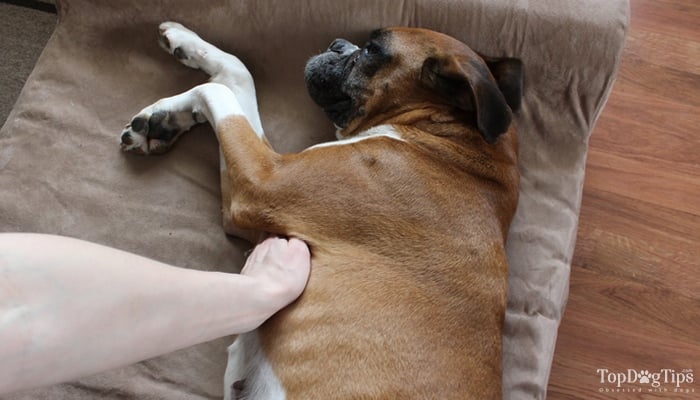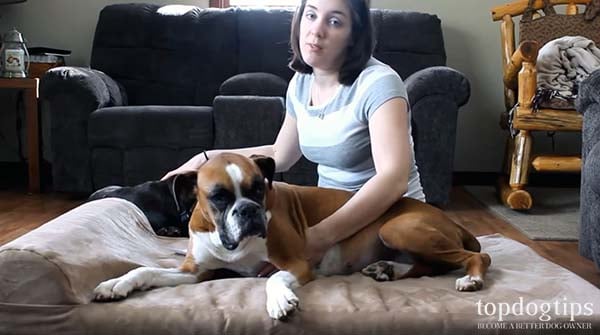You the dog owner are the first line of defense to keeping a dog healthy. You must observe your pet on a regular basis. This will allow you to quickly spot any changes in the dog's mood or behavior, which could be signs of an underlying health condition. Knowing how to check a dog's heart rate and other vital signs is part of this task.
Table of Contents
When you're first trying to check your dog's heart rate, do it several times.
Take a dog's heart rate after you return home from a walk, check it again when he first wakes up in the morning, and check it once more during periods of rest throughout the day. This will let you know the average rate of your dog's heartbeat when he's active and while he's resting.
For health purposes, the most vital heart rate check is done when the dog is relaxing. If you have one, you can use a stethoscope; if not, simply use your hand, because the average dog's heart beat is strong enough to feel with your hand.
So let's talk about the average heart rate of a dog, when the rate is too high or too low, and how to find out what your dog's heart rate is and how to do it at home by yourself.
How to Check a Dog's Heart Rate at Home
1. What Is Dog's Normal Heart Rate?
As I mentioned, it's important to be familiar with your own specific dog's average heart beat so you know what's a fast rate and what's a slow rate. Every dog is different, so normal heart rate will be slightly different for each dog.
Studies have shown that dog's age and demeanor will be the most prominent determining factor in their heart rate (source). It was previously thought that a dog's size, and thus the size of their heart, will determine different heart beat ranges, but recent studies found this not to be true (source; source).
Regardless, if your dog's heart rate is less than 60 beats per minute or greater than 140 beats per minute, then there's likely some health issue – contact your veterinarian immediately (source).
While size itself may not be the ultimate determining factor, the breed does seem to matter, which could also mean it's their genetics. On average, small dog breeds and puppies have faster heart rates than large dog breeds. Dogs that are overweight or obese will have slower heartbeats than dogs that are in a good physical shape (source).
A normal canine heart rate for an average dog is around 60-140 beats per minute. For large breeds, their heart rate will average at 60-100 beats per minute, while for small dogs, their heartbeat will be in 100-140 beats per minute range (source).

2. How to Check a Dog's Heart Rate Yourself at Home
As I explain in my video above, there are two ways to do this:
- Stethoscope. You can buy a stethoscope to keep in your pet's first aid kit. They're fairly cheap on Amazon ($20-80), and we've used this MDF one, which is only $25.
- Hand. Or you can simply use your hand for check a dog's heart rate – a much cheaper option – because it's fairly easy to feel the a dog's heartbeat.
It's easiest to check your dog's heart rate while the dog is lying on their side, like what my Boxer is doing in the above photo. Make sure the dog is comfortable and calm.
3. Find the Dog's Pulse and Do the Math
First, prepare a watch, clock, stopwatch or phone and have it beside you.
Step one. To find your dog's pulse, you must first place your hand under a dog's left front paw where the paw meets the body, or the dog's “armpit”, if you will (see photo above).
Holding your hand there, you should be able to easily feel your dog's heart beating. If you don't feel it, try moving your hand around that area, slowly feeling for the heartbeat. You will find it eventually.
Step two. Once you find the heartbeat on a dog, you'll need that phone, watch, clock with a seconds hand, or a stopwatch. Count the number of times the dog's heart beats in a 15 second time period.
Now, multiply that number by x4. The number you get from that is the number of time your dog's heart beats per minute.
For example, in my video above, you will see that with my dog Chloe, I counted 21 beats in 15 seconds time frame. So doing the math, it's 21 x 4 = 84.
That means my Chloe's heart rate was 84 beats per minute here, which is right in the middle of the normal range, which is good.
Again, if you find your dog's heart rate to be more than 140 beats per minute or less than 60 beats per minute, there's some problem and you must contact your vet immediately.

4. Find the Dog's Pulse by Locating Femoral Artery
If you have trouble finding your dog's heart rate by placing your hand on the dog's chest like I've shown above, then instead you can try to find the dog's femoral artery.
As I show you in my video, a dog's femoral artery can be found on a dog's inner thigh close to where the leg meets the dog's body.
Personally, I find it much more difficult to check a dog's heart rate this way, but you may find it to be a bit easier, depending on your specific dog, their size and coat.
 To find a dog's pulse after you've located their femoral artery, simply place two fingers on the artery and count how many times it pulses in a 15 second span of time – same thing as with the heartbeat instructions above.
To find a dog's pulse after you've located their femoral artery, simply place two fingers on the artery and count how many times it pulses in a 15 second span of time – same thing as with the heartbeat instructions above.
Then, once again, multiple that pulse beat number by x4 and you've got your dog's heart rate per minute, exactly the same as before.
And now you know how to check your dog's heart rate with or without a stethoscope!
READ NEXT: How To Check A Dog’s Vital Signs
Disclosure: We may earn affiliate commissions at no cost to you from the links on this page. This did not affect our assessment of products. Read more here and find full disclosure here.













